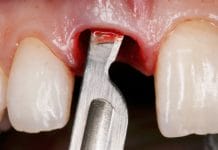Hygienists are always looking to improve the lives and health of dental patients, and we are master educators in all things oral health. We can tell if a patient has been slacking in their normal oral hygiene routine or perhaps hasn’t been eating as well as they usually do. We can even tell if they breathe through their mouth at night.
We are detectives. We are checking everything from health history to blood pressure to biofilm. We are educating patients on the fact that periodontal disease has been scientifically linked to cardiovascular disease, diabetes, cancer, Alzheimer’s disease, rheumatoid arthritis, lung diseases, and adverse pregnancy outcomes, to name a few.1
When having oral-systemic conversations with patients, it is important to realize we can’t do everything alone. We’ve all heard the saying, “Teamwork makes the dream work.” Well, it’s true in health care as well. We educate patients on the link between oral and systemic disease, and there is no reason why we can’t refer patients to a health care practitioner to help them in an area that is out of our scope of practice.
Overall Patient Health Improves
A cardiologist doesn’t treat skin cancer. A proctologist doesn’t treat concussion syndrome. It’s just how it works in the United States. As dental hygienists, we know the mouth is connected to the rest of the body, but going below the neck is out of our zone. We simply can’t treat the whole body. This is why working with other health care practitioners is a total win for our patients’ oral and overall health.
For example, you may review a patient’s health history and see a history of bypass surgery. The patient is on blood pressure meds, yet their current blood pressure is 142/91. It’s totally okay to mention that the meds may not be working as they were intended. Stress to the patient they need to follow up with their primary care physician (PCP). It may feel a little odd, or like you are stepping out of your lane when you first start doing this, but you’re not. They are your patient, and they have entrusted their health to you. When information is delivered in a kind and caring fashion, patients are typically thankful. If they are new to the area or are not entirely happy with their current doctor, wouldn’t they appreciate a referral?
Another example is the patient who comes in and presents with generalized inflammation, yet the patient reports really good home care. You walk them through a protocol to get the mouth back to health. The patient returns three months later, but the situation hasn’t really improved. However, the patient also reports that they just don’t feel their overall health is great, but they can’t pinpoint anything specific.
This dilemma hints at gut dysbiosis. The gut and oral microbiome overlap by 45%.2 This is a great time to introduce them to something like functional medicine. If you’re not familiar with functional medicine, they are doctors who went to medical school. So, yes, they can write prescriptions and have hospital rights. They are MDs and DOs, but they specialize in treating the root cause of diseases. Similar to dental hygienists, they put a heavy emphasis on prevention and spend a lot of time on patient education. You could also introduce them to someone who can help with their gut health. You can explain what it is, give them some referrals, and direct them to those doctors’ websites. I know several doctors who do phone consultations, Zoom consultations, or even live meet-and-greets to see if they are a good fit for you.
I have worked with many doctors who want to know what is on the microscope slide or the results of salivary testing. If you do biofilm evaluations with the microscope, you can easily and instantly tell if it is not healthy. If you find certain things, such as parasites, the dentist may recommend a parasite cleanse for the patient. If you do salivary testing, you will get the results in one to two weeks and can send them to their doctor.
Either way, if the oral microbiome is unhealthy, there is a strong chance the gut microbiome is also unhealthy. The patient will continue to work with both the dental office and the doctor’s office to regain their overall health. It is such a great feeling to see people get better. I have seen patients lower their A1C, become happier, regain mobility, become stronger, grow back hair loss, have more energy during the day, have skin clear up, and breathe through their noses again. All kinds of wonderful things happen when infections and inflammation are decreased.
Happy Patients Love To Talk
Help someone regain their health, and you have a friend for life. The patients who come in the sickest and turn their health around will be your biggest cheerleaders. They will shout it from the rooftops. They will tell anyone and everyone who will listen how bad they felt before and how much better they feel now. They will tell others not only did you address their oral health, but you referred them to and continued to work alongside their other doctors.
This is another way to get those five-star Google reviews! The biggest thing is not the glowing reviews and referrals; it’s getting to see someone’s journey to wellness. It feels good to the soul to see someone actually get healthier. After all, that’s why we got into health care in the first place.
You Learn a Little Something Yourself
After working with many different types of health care providers (primary care providers, functional medicine doctors, chiropractors, naturopathic doctors, functional medicine-trained nutritionists, myofunctional therapists, and physical therapists), you start to learn many new things. You expand your bubble of knowledge. This new information can help improve your patients, family, friends, and even your own health.
A personal example is when ‒ after completing the BaleDoneen Method (BDM) Preceptorship for the prevention of heart attacks, strokes, and type 2 diabetes ‒ I sought out a doctor in my area who graduated from the BDM program to evaluate my husband and me. We became patients of the practice, and both of us had health improvements and have worked with them ever since. I learned so much about nutrition to fuel the body and prevent disease that I could then share with my patients. No joke. At one point, he broke out a diagram of the Krebs cycle. It was a total flashback to biology class. This was part of my own wellness journey, in addition to expanding my referral list for my patients.
Referrals Come Pouring In
It is astounding how many medical doctors do not know about the mouth!3 In one survey of primary care medical providers such as physicians, physician assistants, and nurses, 80% reported little to no training in oral health care.3 Just ask your PCP next time you see them how many classes/hours they received on oral health in medical school.
Sometimes, it’s you that has to initiate contact. Once you reach out to other offices and they also start to treat your patients, they will see the top-notch care you give them. Oral health might just be added to their radar, and when they have patients needing dental care, guess who they will send them to? That’s right, you.
Eventually, you will get to know all the people in these offices, and when they need dental care or a friend or a family member asks about dental care, they refer to you again. When a good relationship is built, you may even review patient cases and discuss concerns and outcomes. It is a wonderful symbiotic relationship that truly benefits patients.
You Have a Bank of Doctors
After you do this for a while, you will have a large bank of doctors to refer to and work with. It is nice to have many options in each specialty for your patients. Different patients have different needs and wants from their health care providers, so it’s good to have plenty of options.
There will sometimes even be very specific needs. I have had many patients who are looking for a plastic surgeon that specializes in explants and will do it en bloc. This is very specific. Did I have someone for this? Not the first time, not the second time, but after a few patients had great results, I had someone I could reach out to. Normally, when you call an office and let them know what you and your patients are looking for, they are more than happy to tell you all about their practice.
It’s really about relationship building. Then, you move forward and share the information with your patients. Eventually, you will have a health care provider for just about every need.
As dental hygienists, we are health care providers. Science supports that periodontal health impacts systemic health, and systemic health impacts oral health. We may work in the mouth, but we know the mouth is connected to the rest of the body and are well aware one can’t have a healthy body while having an infected mouth. Collaborating with other health care providers can be a key component to overall patient wellness.
Before you leave, check out the Today’s RDH self-study CE courses. All courses are peer-reviewed and non-sponsored to focus solely on high-quality education. Click here now.
Listen to the Today’s RDH Dental Hygiene Podcast Below:
References
- Kabila, Y.L. Oral Health’s Inextricable Connection to Systemic Health: Special Populations Bring to Bear Multimodal Relationships and Factors Connecting Periodontal Disease to Systemic Diseases and Conditions. Periodontology 2000. 2021; 87(1): 11-16. https://www.ncbi.nlm.nih.gov/pmc/articles/PMC8457130/
- Olsen, I., Yamazaki, K. Can Oral Bacteria Affect the Microbiome of the Gut? Journal of Oral Microbiology. 2019; 11(1):1586422. https://www.ncbi.nlm.nih.gov/pmc/articles/PMC6427756/
- Laniado, N., Cloidt, M., Altonen, B., Banner, V. Interprofessional Oral Health Collaboration: A Survey of Knowledge and Practice Behaviors of Hospital-Based Primary Care Medical Providers in New York City. Advances in Medical Education and Practice. 2021; 12: 1211-1218. https://www.ncbi.nlm.nih.gov/pmc/articles/PMC8523314/












